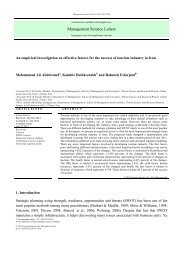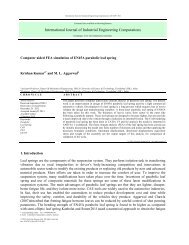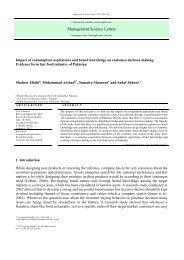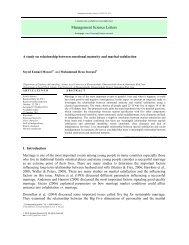PDF (276 K) - Growing Science
PDF (276 K) - Growing Science
PDF (276 K) - Growing Science
You also want an ePaper? Increase the reach of your titles
YUMPU automatically turns print PDFs into web optimized ePapers that Google loves.
332<br />
Table 6<br />
Objective function and its cost components with increased interruption cost<br />
OFV Earliness Tardiness Work-in-process Interruption<br />
1222 80 970 149 23<br />
Table 7<br />
The solution obtained for each job with increased interruption cost<br />
Job number<br />
Completion<br />
Time<br />
No. of<br />
interruption<br />
Flow time<br />
Tardiness<br />
Penalty<br />
Earliness<br />
penalty<br />
1 9 0 6-9 0 0<br />
2 14 1 1-14 2*60$ 0<br />
3 12 1 5-12 0 0<br />
4 19 0 15-19 2*80$ 0<br />
5 29 1 22-29 0 0<br />
6 28 0 26-28 0 1*30$<br />
Further to the explained example, we have also solved several numerical examples of different sizes<br />
and their results are shown in Table 8.<br />
Table 8<br />
Several numerical examples and related cost components of objective functions<br />
No. of Jobs OFV Earliness Tardiness Work-in-process Interruption CPU time<br />
8 1128 470 530 102 26 40’:32”<br />
10 960 620 200 114 26 1:27’:11”<br />
12 880 290 430 128 32 1:22”:49”<br />
15 945 580 200 131 34 2:18’:47”<br />
20 1345 360 690 247 48 3:05’:52”<br />
6. Conclusions and further research<br />
This paper presented a novel integer nonlinear programming model for the single machine scheduling<br />
problem with preemptive jobs in JIT environment to minimize the total tardiness/earliness penalties,<br />
interruption penalties and holding costs of all jobs which are work-in-process. The excellent<br />
advantage of the proposed model is to incorporate penalties of interruption and work-in-process jobs.<br />
The nonlinear formulation of the proposed model was liberalized using an innovative procedure. The<br />
performance of the model was illustrated by a numerical example. Sensitive analysis performed on<br />
interruption cost illustrated the impact of this feature on the model performance. CPU time required<br />
to reach optimal solution for the presented examples shows that obtaining an optimal solution for<br />
such hard problems in a reasonable time is computationally intractable.<br />
An attractive future research trend is to investigate the preemptive jobs in JIT with parallel uniform or<br />
different machines. Also it would be appropriate to consider the problem studied here with the<br />
addition of some other assumptions like sequence dependent setup times. It is also interesting to work<br />
on other solution methods like stochastic algorithms and meta-heuristic algorithms to achieve even<br />
better results.<br />
Appendix A. The Proof of proposition 1<br />
This can be shown for each of the three possible cases that can arise.








